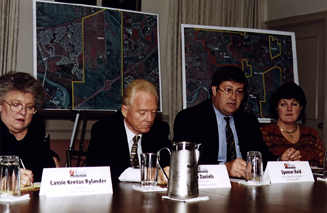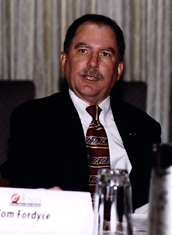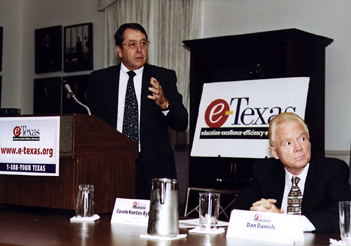| Asset & Financial Management Task Force
Austin, June 27th, 2000
E-Texas Commission Discusses How State Manages Its Assets
Texas state government owns almost 17 million acres, or 10 percent of the state's land. It manages this valuable asset with out-of-date accounting practices and a negative incentive system, according to testimony at the June 27 hearing of e-Texas' Asset and Financial Management Task Force in Austin. Together, these two problems lead to undervalued property that lies dormant or underused.

|
|
Comptroller Rylander; Dan Daniels, Vice President/General Manager, Champion Realty Corporation; Spencer Reid, Senior Deputy Commissioner/Special Counsel, General Land Office, and e-Texas co-team leader Laure McLaughlin
|
Comptroller Carole Keeton Rylander discussed with experts in the field ways to improve the state's asset management, particularly of real estate, during the hearing. E-Texas is the comptroller's citizen commission charged with developing recommendations to help Texas state government meet the challenges of the Internet Age.
Major Issues
Major issues discussed by panelists included:
-
Updating the way the state values its land to bring it to market levels, including updating its accounting methods,
-
Improving the incentive structure for agencies to sell or lease valuable land that is now dormant or underused, and
-
Gathering advice on land usage from public and private sector experts.
Panelists' commentary
Comptroller Rylander kicked off the task force meeting that focused on how the State of Texas manages its assets, in particular, its real estate.
Ms. Rylander pointed out that the State of Texas owns almost 17 million acres or 10 percent of the land area of the state. The list value of all state lands is just over $800 million on an historical cost basis. But historical cost, also known as book value, is only part of the story. Historical cost has nothing to do with what property is actually worth in today's dollars.
All state governments will implement new accounting rules from the Governmental Accounting standards Board, GASB 34, by Sept. 1, 2001. For the first time, all states will be required to account for all of their property at historical cost in their annual budgets.
Ms. Rylander recommended we take GASB 34 a step further and have every state agency account for its properties each year at market value, not just book value. The state will then know the true value of its real estate investments.
Ms. Rylander gave an example of the distortion between book value and market value. The General Land Office has appraised 870,000 acres of land owned by state agencies, or about 5.1 percent of all state lands, at $1.6 billion. This is exactly twice the book value, or historical costs, for all the state's lands.
Ms. Rylander also suggested we shift the emphasis away from the negative incentives the state uses to manage its assets and move toward more positive incentives to sell state properties. Barriers need to be removed in order to maximize value and efficiency.
Bill Eggers, e-Texas Project Director, made a slide presentation of Texas assets in fiscal year 1999. In fiscal year 1999, Texas assets totaled $231 billion. These assets breakdown into the following categories: 83 percent cash, investments and other cash-related assets; 10 percent fixed assets and inventories; and 7 percent all other assets.
Eggers pointed out that the asset and financial management goals were accountability, uniformity, transparency, velocity, efficiency and customer satisfaction.
Spencer Reid, Senior Deputy Commissioner for the General Land Office, gave an overview of asset management from a legislative prospective. In 1985, SB 43 by Sen. John Leedom established the asset management division in the General Land Office (GLO). In 1987 the legislature amended the law to allow GLO to create plans for the development of property. In 1995, SB 1262, allowed the GLO to make recommendations to the governor during the interim for the use of state-owned property that was considered underused.
Reid then went on to describe some program success stories. In 1990, underused state-owned property at 38th Street and Lamar in Austin was developed and now houses Central Market—the number two tourist attraction in Austin behind the State Capitol—the Heart Hospital, the Gables Apartments and a public park. Another land sale in 1998, was a 446-acre former hog farm in an Austin growth corridor along US Highway 183. The Texas Department of Transportation sold it for $18.6 million.

|
|
Tom Fordyce, General Manager, Agra Business Land and Minerals, TDCJ
|
Tom Fordyce, General Manager of the Agri Business Land and Minerals at the Texas Department of Criminal Justice (TDCJ), gave an overview of some of TDCJ's land holdings and assets. Fordyce said TDCJ has 40,000 acres of farmland, 10,000 cows and 300,000 chickens. The 5,000 acres of edible crops at the Jester prison near Sugar Land, Texas, provides 170,000 meals, three times a day. This results in an average cost of $2 a day to feed an inmate in the Texas prison system. Other states average twice that rate. The excess food produced—50 percent—is donated to local food banks.
Spencer Reid estimates that the current value of the approximately 5,000 acres of state-owned land in Sugar Land, Texas, is valued between $75 million to $100 million.
Dan Daniels, Vice President and General Manager of Champion Realty Corporation of Houston, gave a brief overview of how his company manages 5 million acres of primarily timberland. The company first inventoried all its lands and updated the inventory on an annual basis. Champion then applied an expected rate of return for all its divisions, which forced managers to evaluate the value of all assets—especially land—that were being deployed to reach that goal. Managers quickly discovered which properties contributed to the company's bottom line, and which did not. The result was the sale of underperforming assets.
Daniels stressed that Champion's methods were based on a seven-point plan:
-
Break the "more is better" mentality, because it does not always maximize value.
-
Drive the concept of cost of capital down through the organization with training; set common expectations.
-
Evaluate all business sectors for performance and strategic fit, then evaluate their properties.
-
Require every manager to be responsible for achieving their division's goals.
-
Require managers to include a cost of capital target in his or her annual objectives.
-
Reward achievement through annual salary reviews, gain sharing or bonus programs.
-
Share the profits from successful land management.

|
|
Bob McFarland, President, Asset Management Consulting, and Dan Daniels
|
Bob McFarland, President and Engagement Director of Asset Management Consulting in Nellysford, Virginia, had the following recommendations for the State of Texas:
-
Know the difference between accounting and accountability,
-
Integrate all computer systems,
-
Identify and value all state assets,
-
Review all assets every two years and in some cases once a year, and
-
Devise a system that clearly identifies savings.
He gave an example of a major defense contractor who had 23 databases and an annual operating cost of $27 million to run those systems. After those databases were combined into one, operating costs dropped to only $2 million a year.
|

